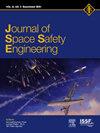Reaching Mars: Medical risks and potential surgical conditions in the Martian environment and during long-duration spaceflight
IF 1.7
Q3 ENGINEERING, AEROSPACE
引用次数: 0
Abstract
Compared to lunar missions, Mars missions will pose additional challenges. This includes a longer duration (currently anticipated to take around three years for a return mission), and a hazardous Martian environment with 0.38 Earth gravity, a thin atmosphere, and a weak magnetosphere. These factors contribute to extreme weather conditions, and significant exposure to space radiation. Evacuation to Earth for medical treatment will be impractical, rendering the capability to provide surgical interventions absolutely necessary. This paper is part of an ongoing scoping review of relevant published scientific literature to identify medical conditions that might require operative or non-operative surgical solutions during long-duration spaceflight. In the context of potential future Mars missions, onboard acute conditions, or newly developed chronic diseases (Type 1), and Mars surface/environment-related surgical conditions (Type 2), provide relevant considerations for future mission planning and crew safety. (Type 1) During long-duration spaceflight, exposure to space radiation and microgravity affects every organ system. This may result in a broad range of medical events requiring diverse operative or non-operative surgical interventions. The likelihood of acute life-threatening events (Type 1a.) is increased, and newly developed chronic diseases (Type 1b.) may also occur. If asymptomatic, but untreated, secondary sudden surgical emergencies may result. On reaching Mars (Type 2), reintroduction of partial gravity (0.38 G), flight-related reduced bone mineral density and potential changes in muscle mass, might lead to increased risk of lumbar disc herniations and traumatic injuries such as fractures. Without adequate space radiation shielding, surface conditions will likely increase the risk for development of malignancies and eye diseases such as cataracts. Communication delays (as long as 24 min each way) will require any immediate medical emergency to be managed in-situ by the expeditioners. Remotely operated robotic surgery is not currently feasible, as any communication lag >100 ms will cause a perceptible delay, potentially affecting surgical outcomes. The provision of healthcare for Mars missions will face unique challenges in terms of both a hostile and extreme environment, and a remote and isolated location without real-time Earth communication. The medical team will need to be equipped to manage a very wide range of health conditions, including low acuity, chronic, and high acuity life-threatening issues, with some potentially requiring surgical intervention. Issues for the treating team include appropriate skill sets and access to medical guidance, facilities, equipment and supplies, and available pharmaceuticals. These significant challenges underlie the importance of adequate anticipation, preparation and planning for the healthcare needs of Mars explorers.
到达火星:火星环境和长时间航天飞行期间的医疗风险和潜在手术条件
与月球任务相比,火星任务将带来额外的挑战。这包括一个更长的持续时间(目前预计需要大约三年的返回任务),一个危险的火星环境,0.38地球引力,稀薄的大气层,弱磁层。这些因素造成了极端的天气条件和严重的空间辐射暴露。撤离到地球接受治疗将是不切实际的,因此提供外科手术干预的能力是绝对必要的。本文是正在进行的一项范围审查的一部分,该审查是对相关已发表的科学文献进行的,目的是确定在长时间航天飞行期间可能需要手术或非手术手术解决方案的医疗状况。在潜在的未来火星任务背景下,机载急性疾病或新发展的慢性病(第一类)以及火星表面/环境相关的外科手术条件(第二类)为未来的任务规划和机组人员安全提供了相关考虑因素。在长时间的太空飞行中,暴露在太空辐射和微重力下会影响每个器官系统。这可能导致广泛的医疗事件需要不同的手术或非手术手术干预。急性危及生命事件(1a型)的可能性增加,也可能发生新发展的慢性疾病(1b型)。如果无症状,但未经治疗,可能会导致继发性突发手术。到达火星(2型)后,部分重力(0.38 G)的重新引入,与飞行相关的骨密度降低和肌肉质量的潜在变化,可能导致腰椎间盘突出和骨折等创伤性损伤的风险增加。如果没有足够的空间辐射屏蔽,表面条件可能会增加恶性肿瘤和白内障等眼疾的发生风险。通信延迟(单程长达24分钟)将要求探险队在现场处理任何紧急医疗情况。远程操作的机器人手术目前还不可行,因为任何100毫秒的通信延迟都会造成可察觉的延迟,潜在地影响手术结果。在恶劣和极端的环境以及没有实时地球通信的偏远和孤立位置,为火星任务提供医疗保健将面临独特的挑战。医疗团队将需要装备来管理非常广泛的健康状况,包括低敏锐度,慢性和高敏锐度危及生命的问题,有些可能需要手术干预。治疗小组面临的问题包括适当的技能组合和获得医疗指导、设施、设备和用品以及现有药品的机会。这些重大挑战凸显了充分预测、准备和规划火星探险者保健需求的重要性。
本文章由计算机程序翻译,如有差异,请以英文原文为准。
求助全文
约1分钟内获得全文
求助全文
来源期刊

Journal of Space Safety Engineering
Engineering-Safety, Risk, Reliability and Quality
CiteScore
2.50
自引率
0.00%
发文量
80
 求助内容:
求助内容: 应助结果提醒方式:
应助结果提醒方式:


